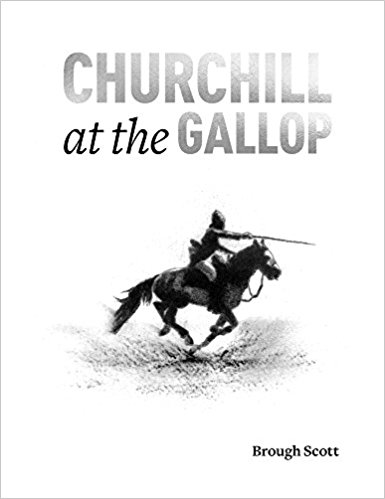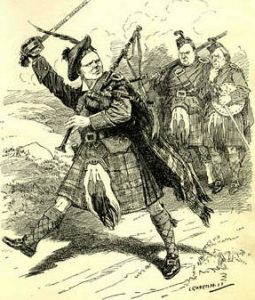
Finest Hour 179
Books, Arts & Curiosities – Saddle Up

May 6, 2018
Finest Hour 179, Winter 2018
Page 41
Brough Scott, Churchill at the Gallop, Racing Post Books, 2017, 229 pages, $34.95/£17.99. ISBN 978–910497364
Review by Fred Glueckstein
Fred Glueckstein is author of Churchill and Colonist II (2014).
In my office hang a number of photographs of Winston Churchill with horses. My favorite is Churchill with a horse named Colonist II, a big grey racehorse that he bought in 1949. Churchill and Colonist II captured the heart of the public and led me to write of their exploits together.
With an admiration for Churchill and a fondness for horses, it was with great anticipation that I looked forward to the release of Brough Scott’s Churchill at the Gallop. Scott, a well-known English jockey, broadcaster, journalist, and author, chronicles Churchill’s lifetime experiences with horses from his youth, serving in the military, and his intervening and senior years, a period stemming from Churchill’s early recollections in Ireland in 1879 to his final years, 1952–65.

2024 International Churchill Conference
Scott acknowledges his writing objective in the Introduction as “an attempt to go back in time and look at Churchill from the only vantage point where I can claim any authority: a view from the saddle.” He begins his account in the summer of 1879, when Winston, at the age of four, had his first involvement with “a four-legged animal.” While visiting Emo Court, a relative’s home in Ireland, young Churchill was put on a donkey. When the donkey shied, he was thrown to the ground.
 Not dispirited from his donkey experience, young Churchill’s interest in horses developed, as he shared his parents’ love for horses and riding. Churchill would take horse-riding lessons in Hyde Park, gallop across the Newmarket Heath, and follow the feats of his father’s race horse, L’Abbesse De Jouarre, which punters named “Abscess on the Jaw.”
Not dispirited from his donkey experience, young Churchill’s interest in horses developed, as he shared his parents’ love for horses and riding. Churchill would take horse-riding lessons in Hyde Park, gallop across the Newmarket Heath, and follow the feats of his father’s race horse, L’Abbesse De Jouarre, which punters named “Abscess on the Jaw.”
Scott writes extremely fascinating accounts of Churchill’s association with horses in the ensuing years, intertwined with the future statesman’s life, such as Churchill’s attendance at the Royal Military College at Sandhurst, where he was a cadet and riding was on the official curriculum.
Young Churchill’s talent as a horseman was demonstrated at Sandhurst during the Riding Examinations, where 127 cadets participated. Churchill was selected as one of fifteen finalists. In the difficult competition, he finished second, with 199 out of 200 marks. He left Sandhurst in 1895 as a subaltern commissioned to the 4th Hussars.
From Sandhurst, Churchill competed for the first time in the steeplechase of the highly controversial 4th Hussars Subalterns Cup. From steeple chasing, point-to-point, polo, and fox hunting in England, Scott provides the reader with meticulous and thrilling accounts of Churchill’s exploits abroad as a cavalry officer and newspaper correspondent. Scott writes of Churchill’s adventures on horseback from 1895 to 1900 in Cuba; India; the North-West Frontier; the famed mounted charge at Omdurman, Sudan, with the 21st Lancers; the Inter-Regimental Polo Championship in Meerut, India; and in South Africa during the Boer War.
Churchill returned home from South Africa in 1900. Yet, as Scott writes, Churchill continued to engage his equestrian passion through fox hunting and polo. By 1925, however, age and parliamentary workloads forced Churchill to give up polo and sell his ponies.
Particularly touching is Scott’s account of the last polo match Churchill ever played, at the age of fifty-two, on 8 January 1927 in Malta—two years after his last contest on a polo pony.
Scott also writes of Churchill’s reconnection with horses in the post-war years 1946–51. This included buying the racehorse Colonist II in 1949, “the first and most famous of runners that Winston was to have over the next 15 years,” writes Scott.
Writing of Churchill and Colonist II, Scott fondly recalls: “As a little boy growing up in London, I remember the pictures in the papers and the images on the Pathé News of the famous old man that my father clearly revered: the Homburg hat, the cheering crowds, the V-for-Victory sign, and the gallant grey and his Scottish jockey Tommy Gosling setting off in front and defying the others to pass.” Scott goes on to tell of Churchill’s happiness in watching other racehorses running and owning the Newchapel Stud near his home in Chartwell.
Extremely well-written, Churchill at the Gallop is highlighted with well-researched historical backdrop and a superb array of photographs illustrating Churchill’s lifetime involvement with horses. Wonderful drawings, paintings, and cartoons add to Churchill’s story and to the splendor of the book.
By riding along Churchill’s “routes,” Scott accomplished his objective “to go back in time” to present “a view from the saddle.” His splendid book is evidence of his own extraordinary experiences with horses, and his knowledge of Winston Churchill, clearly stemming from extensive reading and research.
Churchill at the Gallop is a wonderful addition to the Churchill canon and will be prized by Churchillians. It will also be greatly valued by equestrians and those with a genuine aff ection for the horse.
Subscribe
WANT MORE?
Get the Churchill Bulletin delivered to your inbox once a month.


